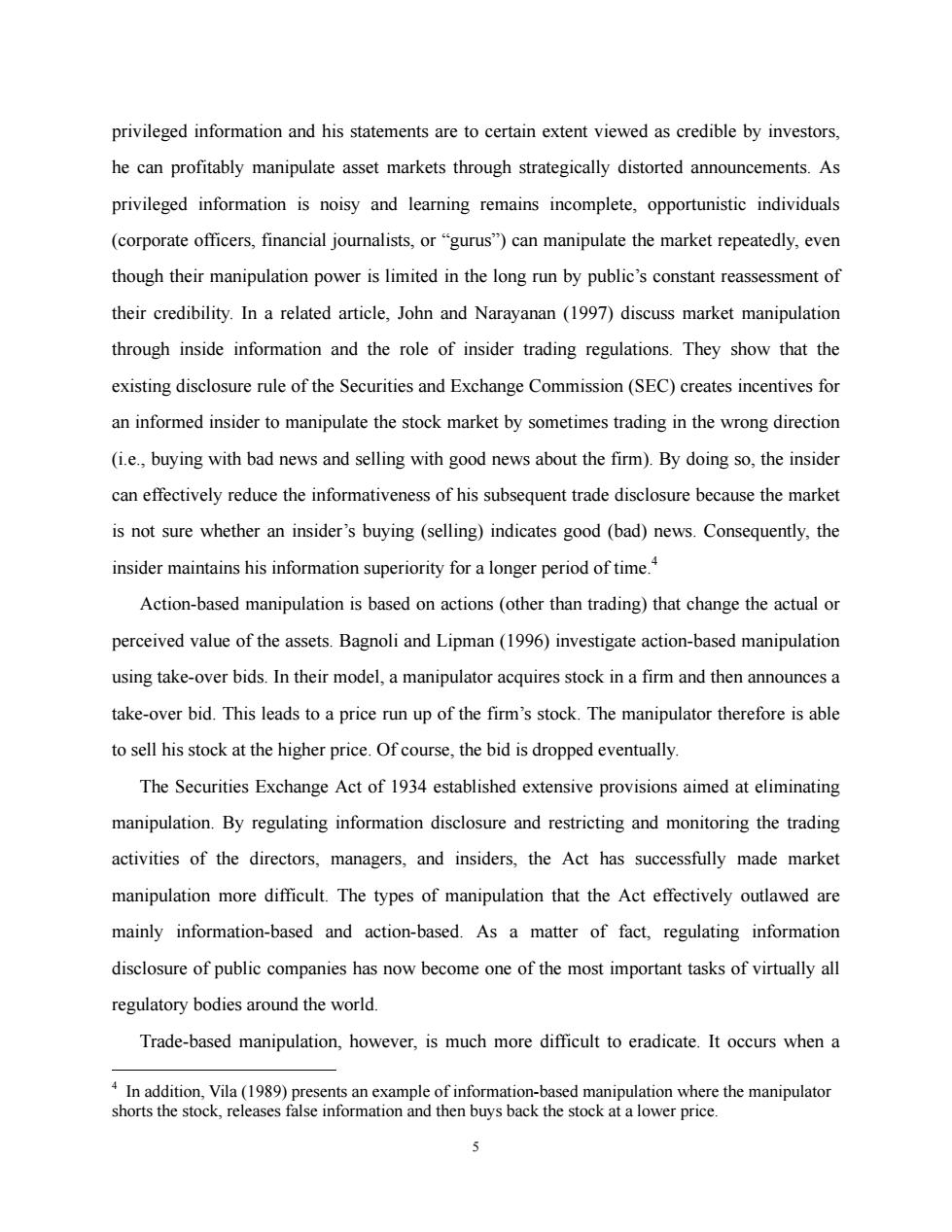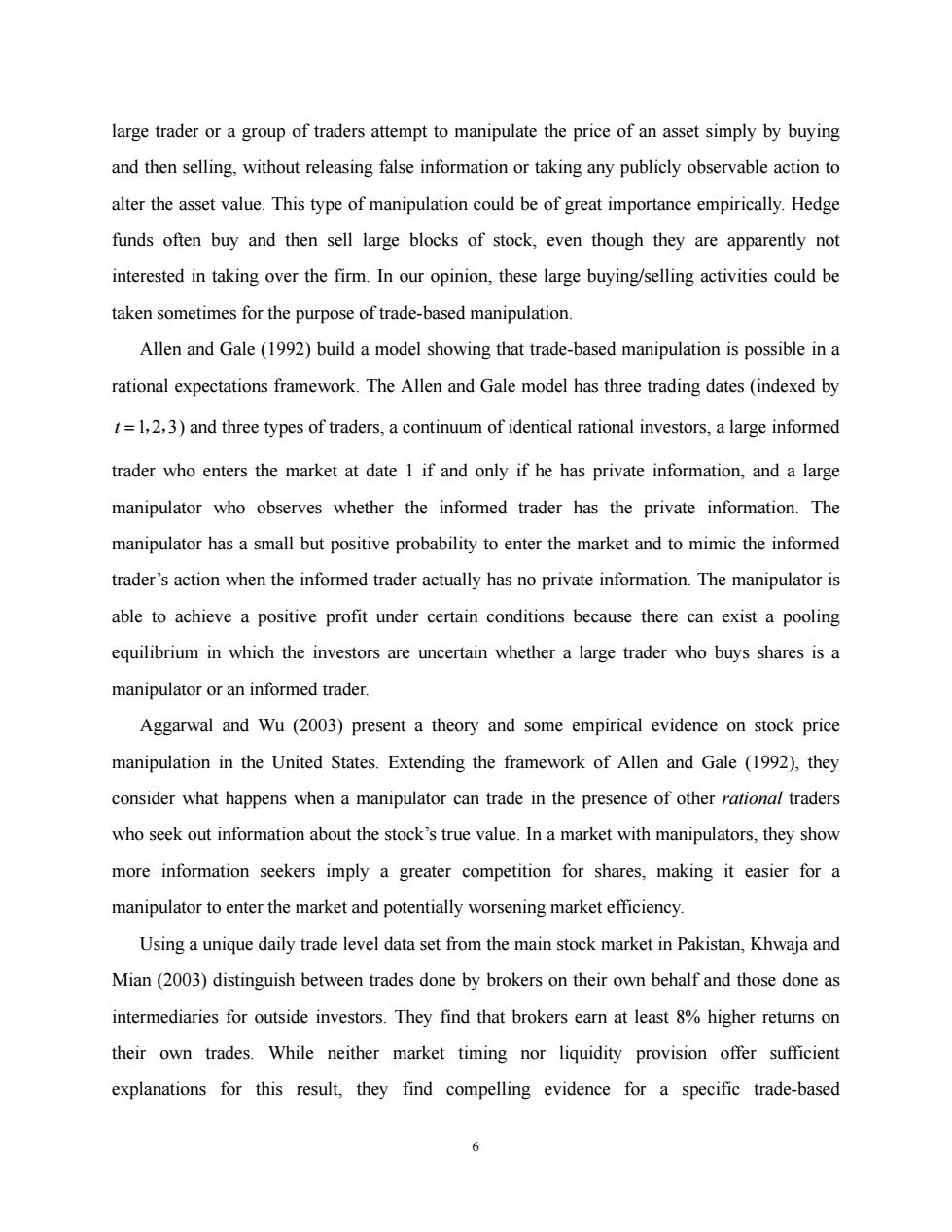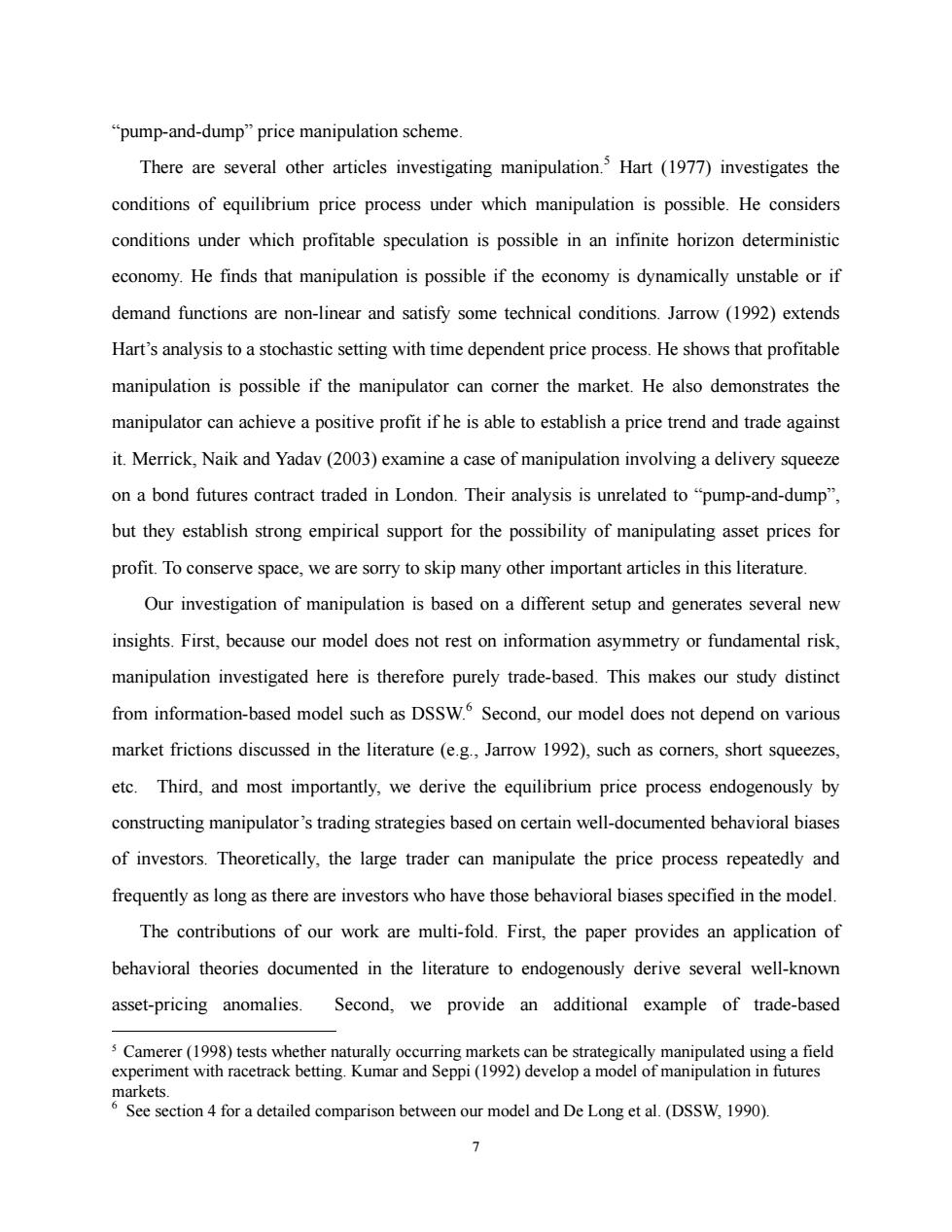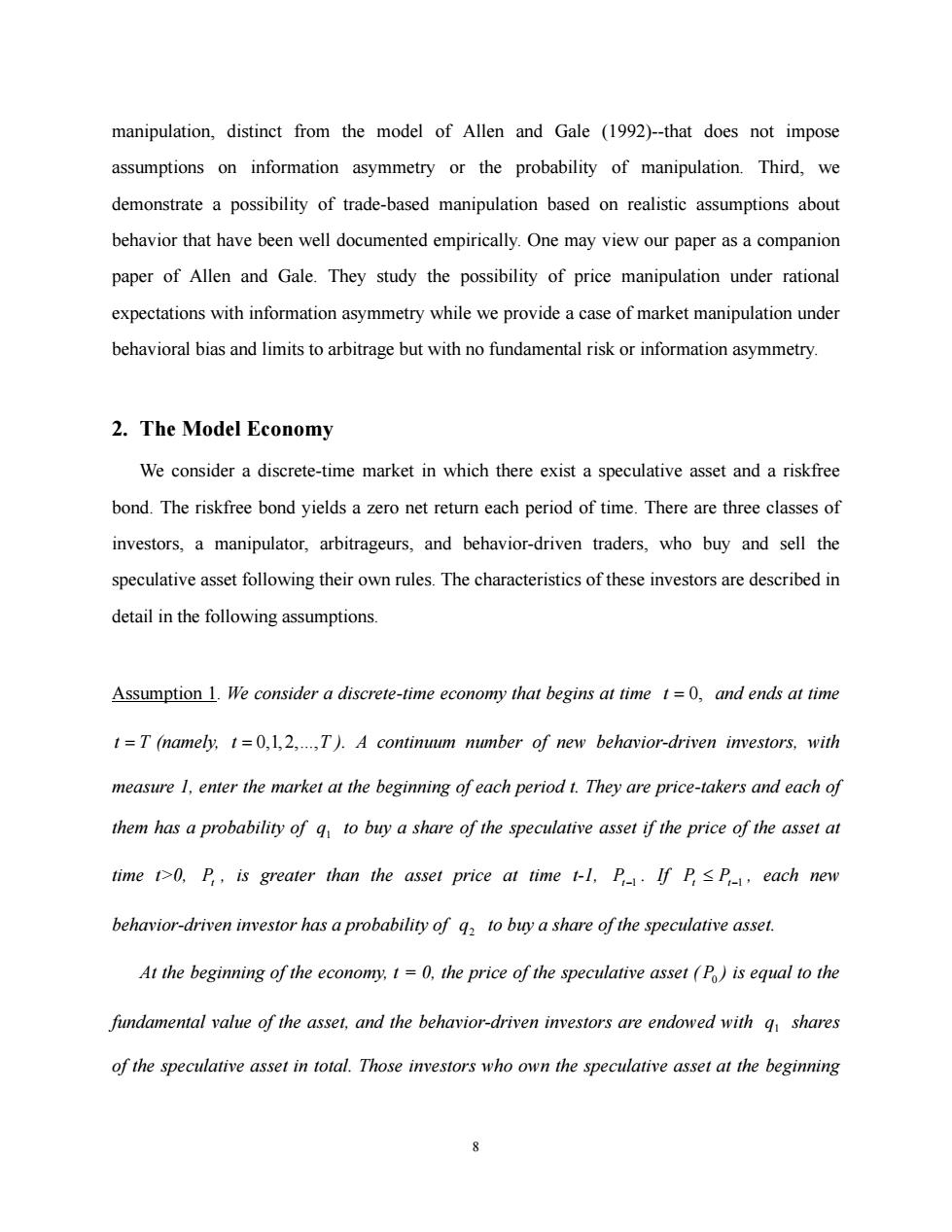
privileged information and his statements are to certain extent viewed as credible by investors, he can profitably manipulate asset markets through strategically distorted announcements.As privileged information is noisy and learning remains incomplete,opportunistic individuals (corporate officers,financial journalists,or "gurus")can manipulate the market repeatedly,even though their manipulation power is limited in the long run by public's constant reassessment of their credibility.In a related article,John and Narayanan (1997)discuss market manipulation through inside information and the role of insider trading regulations.They show that the existing disclosure rule of the Securities and Exchange Commission(SEC)creates incentives for an informed insider to manipulate the stock market by sometimes trading in the wrong direction (i.e.,buying with bad news and selling with good news about the firm).By doing so,the insider can effectively reduce the informativeness of his subsequent trade disclosure because the market is not sure whether an insider's buying (selling)indicates good (bad)news.Consequently,the insider maintains his information superiority for a longer period of time. Action-based manipulation is based on actions (other than trading)that change the actual or perceived value of the assets.Bagnoli and Lipman(1996)investigate action-based manipulation using take-over bids.In their model,a manipulator acquires stock in a firm and then announces a take-over bid.This leads to a price run up of the firm's stock.The manipulator therefore is able to sell his stock at the higher price.Of course,the bid is dropped eventually The Securities Exchange Act of 1934 established extensive provisions aimed at eliminating manipulation.By regulating information disclosure and restricting and monitoring the trading activities of the directors,managers,and insiders,the Act has successfully made market manipulation more difficult.The types of manipulation that the Act effectively outlawed are mainly information-based and action-based.As a matter of fact,regulating information disclosure of public companies has now become one of the most important tasks of virtually all regulatory bodies around the world. Trade-based manipulation,however,is much more difficult to eradicate.It occurs when a 4In addition,Vila(1989)presents an example of information-based manipulation where the manipulator shorts the stock,releases false information and then buys back the stock at a lower price. 5
5 privileged information and his statements are to certain extent viewed as credible by investors, he can profitably manipulate asset markets through strategically distorted announcements. As privileged information is noisy and learning remains incomplete, opportunistic individuals (corporate officers, financial journalists, or “gurus”) can manipulate the market repeatedly, even though their manipulation power is limited in the long run by public’s constant reassessment of their credibility. In a related article, John and Narayanan (1997) discuss market manipulation through inside information and the role of insider trading regulations. They show that the existing disclosure rule of the Securities and Exchange Commission (SEC) creates incentives for an informed insider to manipulate the stock market by sometimes trading in the wrong direction (i.e., buying with bad news and selling with good news about the firm). By doing so, the insider can effectively reduce the informativeness of his subsequent trade disclosure because the market is not sure whether an insider’s buying (selling) indicates good (bad) news. Consequently, the insider maintains his information superiority for a longer period of time.4 Action-based manipulation is based on actions (other than trading) that change the actual or perceived value of the assets. Bagnoli and Lipman (1996) investigate action-based manipulation using take-over bids. In their model, a manipulator acquires stock in a firm and then announces a take-over bid. This leads to a price run up of the firm’s stock. The manipulator therefore is able to sell his stock at the higher price. Of course, the bid is dropped eventually. The Securities Exchange Act of 1934 established extensive provisions aimed at eliminating manipulation. By regulating information disclosure and restricting and monitoring the trading activities of the directors, managers, and insiders, the Act has successfully made market manipulation more difficult. The types of manipulation that the Act effectively outlawed are mainly information-based and action-based. As a matter of fact, regulating information disclosure of public companies has now become one of the most important tasks of virtually all regulatory bodies around the world. Trade-based manipulation, however, is much more difficult to eradicate. It occurs when a 4 In addition, Vila (1989) presents an example of information-based manipulation where the manipulator shorts the stock, releases false information and then buys back the stock at a lower price

large trader or a group of traders attempt to manipulate the price of an asset simply by buying and then selling,without releasing false information or taking any publicly observable action to alter the asset value.This type of manipulation could be of great importance empirically.Hedge funds often buy and then sell large blocks of stock,even though they are apparently not interested in taking over the firm.In our opinion,these large buying/selling activities could be taken sometimes for the purpose of trade-based manipulation. Allen and Gale (1992)build a model showing that trade-based manipulation is possible in a rational expectations framework.The Allen and Gale model has three trading dates(indexed by t=1,2,3)and three types of traders,a continuum of identical rational investors,a large informed trader who enters the market at date 1 if and only if he has private information,and a large manipulator who observes whether the informed trader has the private information.The manipulator has a small but positive probability to enter the market and to mimic the informed trader's action when the informed trader actually has no private information.The manipulator is able to achieve a positive profit under certain conditions because there can exist a pooling equilibrium in which the investors are uncertain whether a large trader who buys shares is a manipulator or an informed trader. Aggarwal and Wu (2003)present a theory and some empirical evidence on stock price manipulation in the United States.Extending the framework of Allen and Gale (1992),they consider what happens when a manipulator can trade in the presence of other rational traders who seek out information about the stock's true value.In a market with manipulators,they show more information seekers imply a greater competition for shares,making it easier for a manipulator to enter the market and potentially worsening market efficiency. Using a unique daily trade level data set from the main stock market in Pakistan,Khwaja and Mian(2003)distinguish between trades done by brokers on their own behalf and those done as intermediaries for outside investors.They find that brokers earn at least 8%higher returns on their own trades.While neither market timing nor liquidity provision offer sufficient explanations for this result,they find compelling evidence for a specific trade-based 6
6 large trader or a group of traders attempt to manipulate the price of an asset simply by buying and then selling, without releasing false information or taking any publicly observable action to alter the asset value. This type of manipulation could be of great importance empirically. Hedge funds often buy and then sell large blocks of stock, even though they are apparently not interested in taking over the firm. In our opinion, these large buying/selling activities could be taken sometimes for the purpose of trade-based manipulation. Allen and Gale (1992) build a model showing that trade-based manipulation is possible in a rational expectations framework. The Allen and Gale model has three trading dates (indexed by t =1,2,3) and three types of traders, a continuum of identical rational investors, a large informed trader who enters the market at date 1 if and only if he has private information, and a large manipulator who observes whether the informed trader has the private information. The manipulator has a small but positive probability to enter the market and to mimic the informed trader’s action when the informed trader actually has no private information. The manipulator is able to achieve a positive profit under certain conditions because there can exist a pooling equilibrium in which the investors are uncertain whether a large trader who buys shares is a manipulator or an informed trader. Aggarwal and Wu (2003) present a theory and some empirical evidence on stock price manipulation in the United States. Extending the framework of Allen and Gale (1992), they consider what happens when a manipulator can trade in the presence of other rational traders who seek out information about the stock’s true value. In a market with manipulators, they show more information seekers imply a greater competition for shares, making it easier for a manipulator to enter the market and potentially worsening market efficiency. Using a unique daily trade level data set from the main stock market in Pakistan, Khwaja and Mian (2003) distinguish between trades done by brokers on their own behalf and those done as intermediaries for outside investors. They find that brokers earn at least 8% higher returns on their own trades. While neither market timing nor liquidity provision offer sufficient explanations for this result, they find compelling evidence for a specific trade-based

"pump-and-dump"price manipulation scheme. There are several other articles investigating manipulation.3 Hart (1977)investigates the conditions of equilibrium price process under which manipulation is possible.He considers conditions under which profitable speculation is possible in an infinite horizon deterministic economy.He finds that manipulation is possible if the economy is dynamically unstable or if demand functions are non-linear and satisfy some technical conditions.Jarrow (1992)extends Hart's analysis to a stochastic setting with time dependent price process.He shows that profitable manipulation is possible if the manipulator can corner the market.He also demonstrates the manipulator can achieve a positive profit if he is able to establish a price trend and trade against it.Merrick,Naik and Yadav(2003)examine a case of manipulation involving a delivery squeeze on a bond futures contract traded in London.Their analysis is unrelated to "pump-and-dump", but they establish strong empirical support for the possibility of manipulating asset prices for profit.To conserve space,we are sorry to skip many other important articles in this literature. Our investigation of manipulation is based on a different setup and generates several new insights.First,because our model does not rest on information asymmetry or fundamental risk, manipulation investigated here is therefore purely trade-based.This makes our study distinct from information-based model such as DSSW.Second,our model does not depend on various market frictions discussed in the literature (e.g.,Jarrow 1992),such as corners,short squeezes, etc.Third,and most importantly,we derive the equilibrium price process endogenously by constructing manipulator's trading strategies based on certain well-documented behavioral biases of investors.Theoretically,the large trader can manipulate the price process repeatedly and frequently as long as there are investors who have those behavioral biases specified in the model. The contributions of our work are multi-fold.First,the paper provides an application of behavioral theories documented in the literature to endogenously derive several well-known asset-pricing anomalies.Second,we provide an additional example of trade-based 5 Camerer(1998)tests whether naturally occurring markets can be strategically manipulated using a field experiment with racetrack betting.Kumar and Seppi(1992)develop a model of manipulation in futures markets. 6 See section 4 for a detailed comparison between our model and De Long et al.(DSSW,1990). >
7 “pump-and-dump” price manipulation scheme. There are several other articles investigating manipulation.5 Hart (1977) investigates the conditions of equilibrium price process under which manipulation is possible. He considers conditions under which profitable speculation is possible in an infinite horizon deterministic economy. He finds that manipulation is possible if the economy is dynamically unstable or if demand functions are non-linear and satisfy some technical conditions. Jarrow (1992) extends Hart’s analysis to a stochastic setting with time dependent price process. He shows that profitable manipulation is possible if the manipulator can corner the market. He also demonstrates the manipulator can achieve a positive profit if he is able to establish a price trend and trade against it. Merrick, Naik and Yadav (2003) examine a case of manipulation involving a delivery squeeze on a bond futures contract traded in London. Their analysis is unrelated to “pump-and-dump”, but they establish strong empirical support for the possibility of manipulating asset prices for profit. To conserve space, we are sorry to skip many other important articles in this literature. Our investigation of manipulation is based on a different setup and generates several new insights. First, because our model does not rest on information asymmetry or fundamental risk, manipulation investigated here is therefore purely trade-based. This makes our study distinct from information-based model such as DSSW.6 Second, our model does not depend on various market frictions discussed in the literature (e.g., Jarrow 1992), such as corners, short squeezes, etc. Third, and most importantly, we derive the equilibrium price process endogenously by constructing manipulator’s trading strategies based on certain well-documented behavioral biases of investors. Theoretically, the large trader can manipulate the price process repeatedly and frequently as long as there are investors who have those behavioral biases specified in the model. The contributions of our work are multi-fold. First, the paper provides an application of behavioral theories documented in the literature to endogenously derive several well-known asset-pricing anomalies. Second, we provide an additional example of trade-based 5 Camerer (1998) tests whether naturally occurring markets can be strategically manipulated using a field experiment with racetrack betting. Kumar and Seppi (1992) develop a model of manipulation in futures markets. 6 See section 4 for a detailed comparison between our model and De Long et al. (DSSW, 1990)

manipulation,distinct from the model of Allen and Gale (1992)--that does not impose assumptions on information asymmetry or the probability of manipulation.Third,we demonstrate a possibility of trade-based manipulation based on realistic assumptions about behavior that have been well documented empirically.One may view our paper as a companion paper of Allen and Gale.They study the possibility of price manipulation under rational expectations with information asymmetry while we provide a case of market manipulation under behavioral bias and limits to arbitrage but with no fundamental risk or information asymmetry. 2.The Model Economy We consider a discrete-time market in which there exist a speculative asset and a riskfree bond.The riskfree bond yields a zero net return each period of time.There are three classes of investors,a manipulator,arbitrageurs,and behavior-driven traders,who buy and sell the speculative asset following their own rules.The characteristics of these investors are described in detail in the following assumptions. Assumption 1.We consider a discrete-time economy that begins at time t=0,and ends at time t=T (namely,t=0,1,2,...,T).A continuum number of new behavior-driven investors,with measure 1,enter the market at the beginning of each period t.They are price-takers and each of them has a probability of q to buy a share of the speculative asset if the price of the asset at time t>0.P,is greater than the asset price at time t-1.P.If P.<P,each new behavior-driven investor has a probability of q2 to buy a share of the speculative asset. At the beginning of the economy,t=0,the price of the speculative asset (P)is equal to the fundamental value of the asset,and the behavior-driven investors are endowed with q shares of the speculative asset in total.Those investors who own the speculative asset at the beginning
8 manipulation, distinct from the model of Allen and Gale (1992)--that does not impose assumptions on information asymmetry or the probability of manipulation. Third, we demonstrate a possibility of trade-based manipulation based on realistic assumptions about behavior that have been well documented empirically. One may view our paper as a companion paper of Allen and Gale. They study the possibility of price manipulation under rational expectations with information asymmetry while we provide a case of market manipulation under behavioral bias and limits to arbitrage but with no fundamental risk or information asymmetry. 2. The Model Economy We consider a discrete-time market in which there exist a speculative asset and a riskfree bond. The riskfree bond yields a zero net return each period of time. There are three classes of investors, a manipulator, arbitrageurs, and behavior-driven traders, who buy and sell the speculative asset following their own rules. The characteristics of these investors are described in detail in the following assumptions. Assumption 1. We consider a discrete-time economy that begins at time t and ends at time = 0, t = T (namely, t T = 0,1,2,..., ). A continuum number of new behavior-driven investors, with measure 1, enter the market at the beginning of each period t. They are price-takers and each of them has a probability of 1 q to buy a share of the speculative asset if the price of the asset at time t>0, P , is greater than the a t sset price at time t-1, P . If t−1 P , each new t ≤ Pt−1 behavior-driven investor has a probability of 2 q to buy a share of the speculative asset. At the beginning of the economy, t = 0, the price of the speculative asset ( P ) is equal to the 0 fundamental value of the asset, and the behavior-driven investors are endowed with 1 q shares of the speculative asset in total. Those investors who own the speculative asset at the beginning

of the economy take P as the initial acquiring cost per share of the speculative asset. The new behavior-driven investors at time t>0 who do not buy the speculative asset choose to leave the market right away.The old generations of behavior-driven investors who entered the market before t>0 do not buy any more shares at time t.Behavior-driven investors like to take quick profits.They sell their shares as soon as they have made a profit and then leave the market. Consider a behavior-driven investor who buys a share of the speculative asset at time t and has not sold his share by the beginning of time t+k (k>0).If P<P he shall liquidate his share in the period of t+k for sure:if P.z P he will have a probability of q3 <1 to liquidate his share in the period of t+k.Behavior-driven investors leave the market right after they have liquidated their shares. The assumption 3<1 plays a critical role in our model,which is made on the basis of the dispositional effect as explained below.Empirical studies suggest that investors often follow a momentum trading (positive feedback trading)strategy that implies q2<g.Although the momentum feature is of importance empirically and will be discussed throughout the article,we do not need q2<q to generate"pump-and-dump"manipulation in our model.As a matter of fact,the momentum feature indicates that the behavior-driven investors buy fewer shares in a down market,which makes"pump-and-dump"manipulation more difficult.However,as long as the dispositional effect dominates,the manipulator can successfully profit from “pump-and-dump”strategy. Dispositional effect is a well-documented empirical phenomenon.According to Shefrin and Statman (1985),Odean (1998),Grinblatt and Han (2001),etc.,investors,especially the individual ones,are more likely to sell stocks that have gone up in value relative to their purchase price,rather than stocks that have gone down.Two behavioral explanations for the dispositional effect have been suggested in the literature.The first explanation suggests that investors may have a biased belief in mean-reversion.The second explanation relies on prospect 9
9 of the economy take P as the initial acquiring cost per share of the speculative asset. 0 The new behavior-driven investors at time t>0 who do not buy the speculative asset choose to leave the market right away. The old generations of behavior-driven investors who entered the market before t>0 do not buy any more shares at time t. Behavior-driven investors like to take quick profits. They sell their shares as soon as they have made a profit and then leave the market. Consider a behavior-driven investor who buys a share of the speculative asset at time t and has not sold his share by the beginning of time t + k (k > 0) . If Pt < Pt+k , he shall liquidate his share in the period of t + k for sure; if Pt ≥ Pt+k , he will have a probability of q to 3 < 1 liquidate his share in the period of t + k . Behavior-driven investors leave the market right after they have liquidated their shares. The assumption 1 q3 < plays a critical role in our model, which is made on the basis of the dispositional effect as explained below. Empirical studies suggest that investors often follow a momentum trading (positive feedback trading) strategy that implies 2 1 q < q . Although the momentum feature is of importance empirically and will be discussed throughout the article, we do not need 2 1 q < q to generate “pump-and-dump” manipulation in our model. As a matter of fact, the momentum feature indicates that the behavior-driven investors buy fewer shares in a down market, which makes “pump-and-dump” manipulation more difficult. However, as long as the dispositional effect dominates, the manipulator can successfully profit from “pump-and-dump” strategy. Dispositional effect is a well-documented empirical phenomenon. According to Shefrin and Statman (1985), Odean (1998), Grinblatt and Han (2001), etc., investors, especially the individual ones, are more likely to sell stocks that have gone up in value relative to their purchase price, rather than stocks that have gone down. Two behavioral explanations for the dispositional effect have been suggested in the literature. The first explanation suggests that investors may have a biased belief in mean-reversion. The second explanation relies on prospect